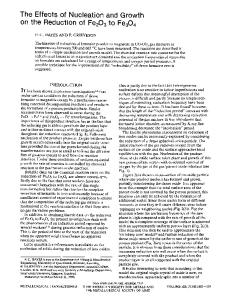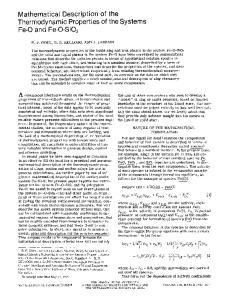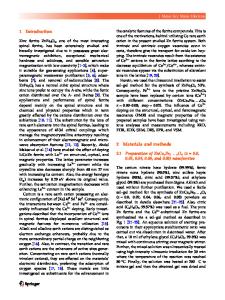Electrochemical determination of thermodynamic properties and x-ray diffraction investigation of the Fe 3 O 4 -ZnFe 2 O
- PDF / 700,927 Bytes
- 7 Pages / 603.28 x 783.28 pts Page_size
- 16 Downloads / 327 Views
I.
INTRODUCTION
THERMODYNAMIC properties of the Fe304-ZnFe204 system were determined by the Bureau of Mines as a part of its program to expand the base of scientific information needed to devise innovative technologies. The thermodynamic behavior of the Zn-Fe-O system is of considerable interest in extractive metallurgy and in the electronics industry. The formation of zinc ferrite during roasting of zinc concentrates is one of the major causes of zinc losses in conventional metallurgical processes. Preparation of zinc and mixed ferrites with the desired magnetic properties for the electronics industry requires a quantitative knowledge of the thermodynamic properties that interrelate activities, temperatures, and phase composition. Results of several phase diagram 1,2 and X-ray diffraction 3'4 studies have been reported; however, these data are inadequate to provide a quantitative characterization of the thermodynamic stability of the Zn-Fe-O system. Thermodynamic data for stoichiometric Z n F e 2 0 4 (zinc ferrite) that have been reported include heat capacity and entropy data obtained from calorimetric measurements.5'6 A Gibbs energy of formation of ZnFe204 from a gas-phase equilibrium study7 has also been reported. Large positive deviations from ideal solution behavior for the activities of the components in the Fe3Oa-ZnFe204 system were obtained by a gas-phase equilibrium investigation. 8 An emf study9 of this system r~ported ideal solution behavior while a more recent emf investigation 1~reported a negative deviation from Raoult's law. In view of these conflicting data, the purpose of this investigation was to obtain accurate activity data for Fe304 in the Fe304-ZnFe204 system by measuring the oxygen potential of zinc oxyferrite solid solutions that coexist with Fe203. The method used was designed to obtain accurate equilibrium dissociation pressures of oxygen for metal oxide-metal oxyferrite systems and thereby determine the activities of f e 3 0 4 in the solid solution. Application of stabilized ZrO2 as a selective solid anion electrolyte has been demonstrated in determining Gibbs S.C. SCHAEFER (retired), Metallurgist, and R.A. McCUNE, Research Chemist, are with Albany Research Center, Bureau of Mines, P.O. Box 70, Albany, OR 97321. Manuscript submitted January 15, 1986. METALLURGICALTRANSACTIONS B
energies for cell reactions involving metal-metal oxide systems at elevated temperatures.11 Within the limitation of the ionic domain of stabilized ZrO2 any equilibrium involving oxygen may be investigated by this technique. 12The method is based on the measurement of the difference in the chemical potential between the known oxygen potential of a reference electrode and the chemical potential of an electrode of unknown oxygen potential. The standard states are the saturated coexisting phases. The transference number of oxygen is essentially unity in the range of oxygen potential of this investigation.12 The relationship between the opencircuit potential of the cell and the Gibbs energy change for the actual ce
Data Loading...











